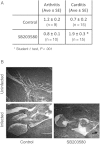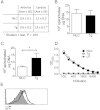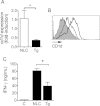Macrophage p38 mitogen-activated protein kinase activity regulates invariant natural killer T-cell responses during Borrelia burgdorferi infection
- PMID: 22551807
- PMCID: PMC3490691
- DOI: 10.1093/infdis/jis332
Macrophage p38 mitogen-activated protein kinase activity regulates invariant natural killer T-cell responses during Borrelia burgdorferi infection
Abstract
The interaction of macrophages with infectious agents leads to the activation of several signaling cascades, including mitogen-activated protein (MAP) kinases, such as p38. We now demonstrate that p38 MAP kinase-mediated responses are critical components to the immune response to Borrelia burgdorferi. The pharmacological and genetic inhibition of p38 MAP kinase activity during infection with the spirochete results in increased carditis. In transgenic mice that express a dominant negative form of p38 MAP kinase specifically in macrophages, production of the invariant natural killer T (iNKT) cell-attracting chemokine MCP-1 and of the antigen-presenting molecule CD1d are significantly reduced. The expression of the transgene therefore results in the deficient infiltration of iNKT cells, their decreased activation, and a diminished production of interferon γ (IFN-γ), leading to increased bacterial burdens and inflammation. These results show that p38 MAP kinase provides critical checkpoints for the protective immune response to the spirochete during infection of the heart.
Figures





Similar articles
-
Control of Borrelia burgdorferi-specific CD4+-T-cell effector function by interleukin-12- and T-cell receptor-induced p38 mitogen-activated protein kinase activity.Infect Immun. 2006 Oct;74(10):5713-7. doi: 10.1128/IAI.00623-06. Infect Immun. 2006. PMID: 16988247 Free PMC article.
-
Local production of IFN-gamma by invariant NKT cells modulates acute Lyme carditis.J Immunol. 2009 Mar 15;182(6):3728-34. doi: 10.4049/jimmunol.0804111. J Immunol. 2009. PMID: 19265151 Free PMC article.
-
Negative modulation of invariant natural killer T cell responses to glycolipid antigens by p38 MAP kinase.Int Immunopharmacol. 2010 Sep;10(9):1068-76. doi: 10.1016/j.intimp.2010.06.007. Epub 2010 Jun 11. Int Immunopharmacol. 2010. PMID: 20584631
-
Murine Lyme arthritis development mediated by p38 mitogen-activated protein kinase activity.J Immunol. 2002 Jun 15;168(12):6352-7. doi: 10.4049/jimmunol.168.12.6352. J Immunol. 2002. PMID: 12055252 Free PMC article.
-
Functions of CD1d-Restricted Invariant Natural Killer T Cells in Antimicrobial Immunity and Potential Applications for Infection Control.Front Immunol. 2018 Jun 6;9:1266. doi: 10.3389/fimmu.2018.01266. eCollection 2018. Front Immunol. 2018. PMID: 29928278 Free PMC article. Review.
Cited by
-
Macrophage mediated recognition and clearance of Borrelia burgdorferi elicits MyD88-dependent and -independent phagosomal signals that contribute to phagocytosis and inflammation.BMC Immunol. 2021 May 17;22(1):32. doi: 10.1186/s12865-021-00418-8. BMC Immunol. 2021. PMID: 34000990 Free PMC article.
-
A multi-omic analysis reveals the regulatory role of CD180 during the response of macrophages to Borrelia burgdorferi.Emerg Microbes Infect. 2018 Mar 7;7(1):19. doi: 10.1038/s41426-017-0018-5. Emerg Microbes Infect. 2018. PMID: 29511161 Free PMC article.
-
invariant Natural Killer T Cells Modulate the Peritoneal Macrophage Response to Polymicrobial Sepsis.J Surg Res. 2024 Aug;300:211-220. doi: 10.1016/j.jss.2024.03.037. Epub 2024 Jun 1. J Surg Res. 2024. PMID: 38824851 Free PMC article.
-
Ikaros mediates the DNA methylation-independent silencing of MCJ/DNAJC15 gene expression in macrophages.Sci Rep. 2015 Sep 30;5:14692. doi: 10.1038/srep14692. Sci Rep. 2015. PMID: 26419808 Free PMC article.
-
Onco-immunomodulatory properties of pharmacological interference with RAS-RAF-MEK-ERK pathway hyperactivation.Front Oncol. 2022 Jul 27;12:931774. doi: 10.3389/fonc.2022.931774. eCollection 2022. Front Oncol. 2022. PMID: 35965494 Free PMC article. Review.
References
-
- Wooten RM, Ma Y, Yoder RA, et al. Toll-like receptor 2 is required for innate, but not acquired, host defense to Borrelia burgdorferi. J Immunol. 2002;168:348–55. - PubMed
-
- Behera AK, Hildebrand E, Uematsu S, Akira S, Coburn J, Hu LT. Identification of a TLR-independent pathway for Borrelia burgdorferi-induced expression of matrix metalloproteinases and inflammatory mediators through binding to integrin α3β1. J Immunol. 2006;177:657–64. - PubMed
-
- Hirschfeld M, Kirschning CJ, Schwandner R, et al. Cutting edge: inflammatory signaling by Borrelia burgdorferi lipoproteins is mediated by toll-like receptor 2. J Immunol. 1999;163:2382–6. - PubMed
-
- Ebnet K, Brown KD, Siebenlist UK, Simon MM, Shaw S. Borrelia burgdorferi activates nuclear factor-kappa B and is a potent inducer of chemokine and adhesion molecule gene expression in endothelial cells and fibroblasts. J Immunol. 1997;158:3285–92. - PubMed
Publication types
MeSH terms
Substances
Grants and funding
LinkOut - more resources
Full Text Sources
Medical
Miscellaneous

